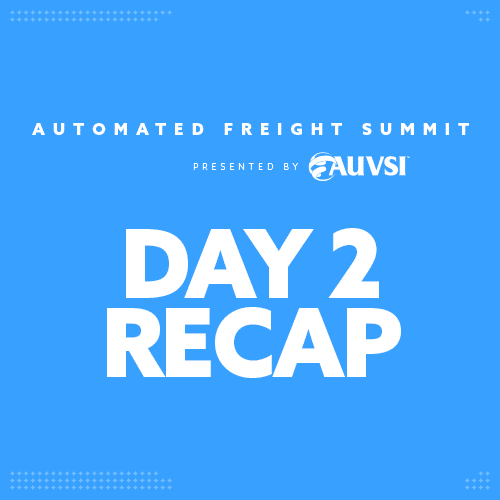Automated Freight Summit: Day Two
July 8, 2021 | AUVSI News

AUVSI today hosted Day Two of the first-ever Automated Freight Summit (AFS). Throughout panel discussions on, “Public Safety Stakeholder Interactions with Automated Freight,” “Truck Operators of the Future,” “What Does Safety Mean for Automated Trucks?” and “Societal Impacts of Automated Freight,” all panelists returned to the most important topic at hand: safety.
Captain Arnold Hardy of the California Highway Patrol summed up the day succinctly by saying, “It’s all about safety,” and Dan Goff of Kodiak Robotics echoed the sentiment when he asserted that, “Safety is really the core technology we are all building on the development side.”
Below are three key items that representatives from industry, regulatory, and academia identified that stakeholders can take action on today to improve road safety and support safe deployment of autonomous vehicle (AV) technology in the freight sector:
1. Companies should leverage test data to build a societal case for automated trucking safety.
Leaders from Foretellix, Aurora, Plus and Luminar Technologies discussed different approaches to testing their AV technology, including virtual and on-road testing. All agreed that robust testing is critical so that the industry can collect enough data to present a strong safety case based on trustworthiness and predictability – and that important safety data should be shared with regulators and other safety stakeholders.
Aaron Jefferson from Luminar Technologies suggested that with all companies tracking large amounts of data, the entire industry should coalesce to streamline the data collection process, share data with each other, and compile the data to make a societal case for safety.
2. Labor and industry leaders should plan now to seize opportunities that support worker safety, even in the face of changing labor needs.
Automated freight can help the industry resolve enormous obstacles it currently faces in the ecommerce era, with consumer demands for fast delivery colliding with a daunting workforce shortage. But as automated freight moves closer toward deployment, the need grows to address anticipated changes in the freight workforce.
With trucking rated the fourth most dangerous job in the U.S., advanced and automated technologies that can improve driving safety could save lives. Other positive benefits could include the creation of new, high wage jobs that combine careers in freight and STEM; decreased emissions that could improve air quality; and equity for communities that have historically been left out of transportation discussions.
Sam Loesche from the Teamsters shared how the union wants to see the benefits that new technologies could have on workers come to fruition – without also seeing unintended consequences that would harm the workforce.
Other panelists shared use cases where commercially-licensed drivers will still be needed even in an era of automated long-haul trucking, including last-mile delivery from the distribution center, providing customer service, interfacing with law enforcement during inspections, and when hauling certain freight such as hazmat.
By planning ahead to address workforce needs, the industry can usher in a smooth transition to automated freight in a way that realizes the promises of improved worker and road user safety.
3. AV companies must communicate with law enforcement long before pilot launch.
As Laura Perrotta, of the American Highway Users Alliance stated, “It’s all about communication.”
Panelists urged companies to build relationships with regulators and law enforcement in areas they want to reach while they are still in the technology development stage, long before deployment. Open channels of communication give law enforcement the information they need to safely respond to any incidents that involve automated trucks. In instances where highway patrol officers are wary of automated trucks, education about the technology is the missing link to achieve trust and confidence.
The Automated Freight Summit will conclude on Friday. Tune in here for more programming on the Cavnue success story and a deep dive on last-mile delivery.
- Industry News


